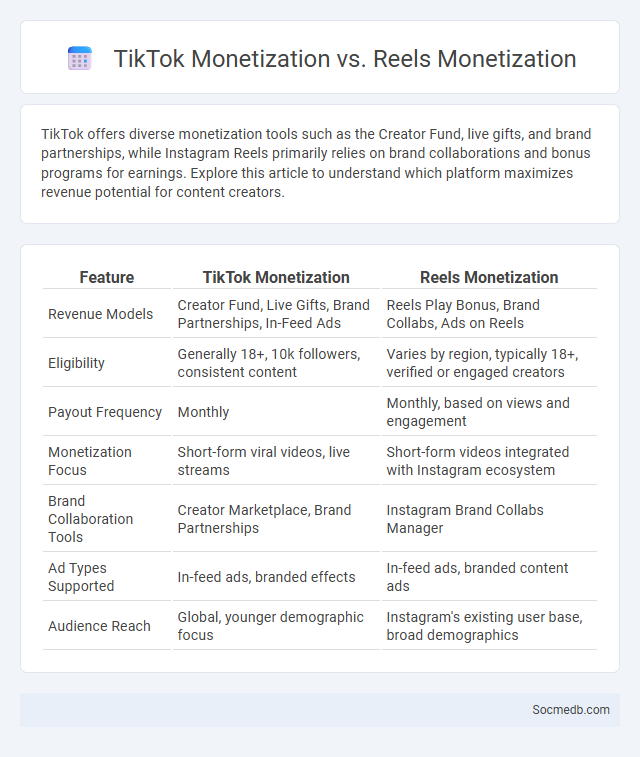
Photo illustration: TikTok Monetization vs Reels Monetization
TikTok offers diverse monetization tools such as the Creator Fund, live gifts, and brand partnerships, while Instagram Reels primarily relies on brand collaborations and bonus programs for earnings. Explore this article to understand which platform maximizes revenue potential for content creators.
Table of Comparison
| Feature | TikTok Monetization | Reels Monetization |
|---|---|---|
| Revenue Models | Creator Fund, Live Gifts, Brand Partnerships, In-Feed Ads | Reels Play Bonus, Brand Collabs, Ads on Reels |
| Eligibility | Generally 18+, 10k followers, consistent content | Varies by region, typically 18+, verified or engaged creators |
| Payout Frequency | Monthly | Monthly, based on views and engagement |
| Monetization Focus | Short-form viral videos, live streams | Short-form videos integrated with Instagram ecosystem |
| Brand Collaboration Tools | Creator Marketplace, Brand Partnerships | Instagram Brand Collabs Manager |
| Ad Types Supported | In-feed ads, branded effects | In-feed ads, branded content ads |
| Audience Reach | Global, younger demographic focus | Instagram's existing user base, broad demographics |
Introduction to Social Media Video Monetization
Social media platforms offer diverse opportunities for video monetization, allowing content creators to generate revenue through ads, sponsorships, and fan support. Utilizing features like YouTube's AdSense, Facebook's In-stream Ads, or TikTok's Creator Fund can maximize your earnings from social media videos. Understanding platform-specific algorithms and audience engagement metrics is essential to optimize your video monetization strategy effectively.
Overview of TikTok Monetization Strategies
TikTok monetization strategies revolve around creator funds, brand partnerships, and in-app purchases such as virtual gifts during live streams. The TikTok Creator Fund allocates billions annually to reward content creators based on video engagement and viewership metrics. Influencers leverage partnerships with brands for sponsored content, while TikTok's e-commerce integrations enable direct product sales and affiliate marketing.
Reels Monetization: Features and Opportunities
Reels monetization offers creators innovative features such as in-stream ads, brand partnerships, and fan support tools that turn engagement into revenue. Leveraging these opportunities can significantly boost your income by capitalizing on viral short-form video content and expanding your audience reach. Understanding algorithm optimization and content trends will maximize your earnings potential through targeted and effective Reels strategies.
Vertical Video Monetization Trends in 2024
Vertical video monetization trends in 2024 highlight a surge in short-form content platforms like TikTok, Instagram Reels, and YouTube Shorts, driving increased advertising revenue through native ad formats and influencer partnerships. Brands are leveraging AI-driven analytics to optimize vertical video ad placements, enhancing user engagement and click-through rates. Sponsored content, live shopping features, and subscription models are emerging as key revenue streams, capitalizing on the growing mobile-first audience's preference for vertical video consumption.
Revenue Potential: TikTok vs Reels vs Vertical Video
TikTok generates over $11 billion in annual revenue, leveraging highly engaging vertical video formats that drive user interaction and advertising effectiveness. Instagram Reels, integrated into the broader Instagram ecosystem with over 2 billion users, contributes significantly to Meta's $140 billion ad revenue by capitalizing on short-form video trends and influencer marketing. Vertical videos outperform traditional formats by boosting viewer retention and click-through rates, making them a key driver of social media monetization strategies.
Audience Demographics and Engagement Comparison
Understanding social media audience demographics helps tailor content to maximize engagement by analyzing age, gender, location, and interests. Platforms like Instagram tend to attract younger users aged 18-34, while Facebook's user base skews older, offering varied engagement potential depending on your target market. Your strategy should leverage these insights to compare engagement rates, such as likes, shares, and comments, across platforms for optimized reach and interaction.
Creator Eligibility and Monetization Requirements
To qualify for social media creator eligibility, you must meet platform-specific criteria such as a minimum follower count, consistent content posting, and adherence to community guidelines. Monetization requirements often include reaching a threshold of watch hours or video views, maintaining an active audience, and complying with advertiser-friendly policies. Ensuring Your content aligns with these standards maximizes opportunities for earning revenue through brand partnerships, ads, and fan support features.
Platform Algorithms and Video Discovery
Platform algorithms play a crucial role in optimizing video discovery by analyzing user behavior, preferences, and engagement patterns to personalize content feeds. These algorithms prioritize videos with higher relevance, watch time, and interaction rates, enhancing visibility for creators and increasing user retention. Understanding these mechanisms enables effective content strategies that boost organic reach and audience growth on social media platforms.
Brand Partnerships and Sponsored Content Integration
Brand partnerships and sponsored content integration drive substantial engagement and revenue growth on social media platforms by aligning influencer authenticity with brand messaging. Effective collaboration leverages detailed audience analytics and native advertising techniques to enhance brand visibility while maintaining user trust. Optimizing these integrations involves strategic content placement and performance tracking through social media insights and conversion metrics.
Choosing the Best Platform for Maximizing Earnings
Choosing the best social media platform for maximizing earnings depends on audience demographics, content type, and monetization options. Instagram offers high engagement for visual brands, while YouTube provides robust ad revenue and sponsorship opportunities for video creators. TikTok excels in viral content and brand partnerships, making it ideal for businesses targeting Gen Z and millennial markets.
 socmedb.com
socmedb.com